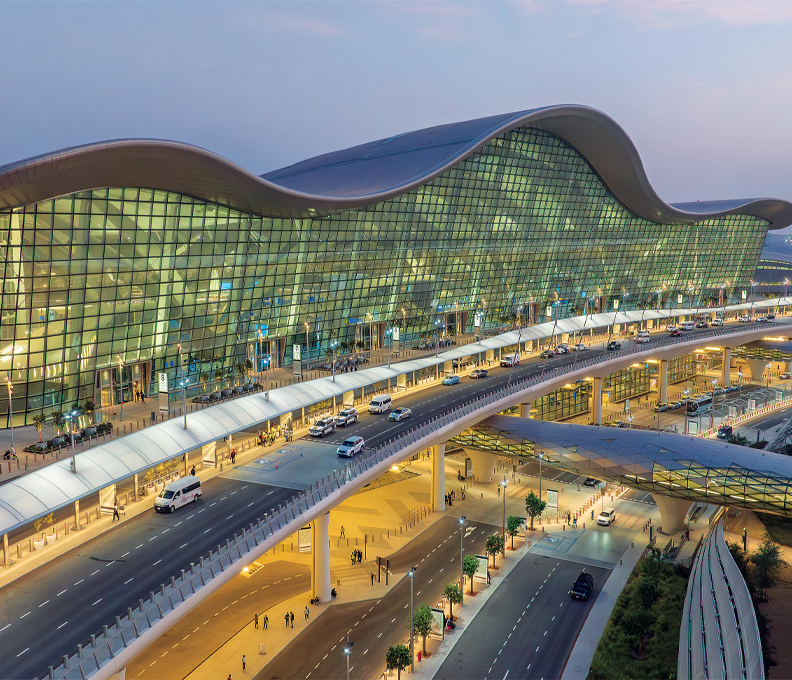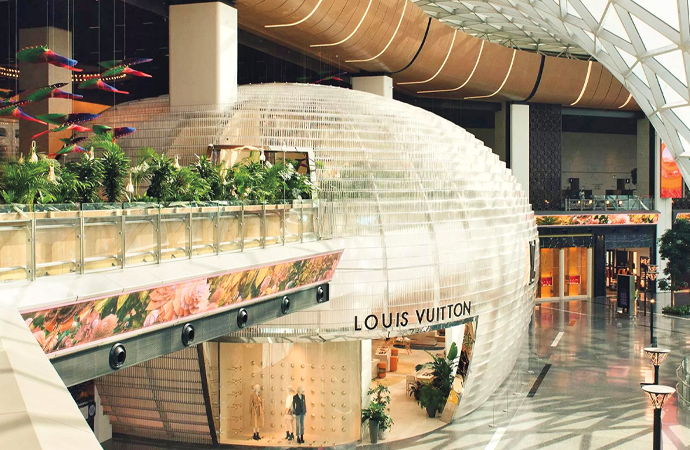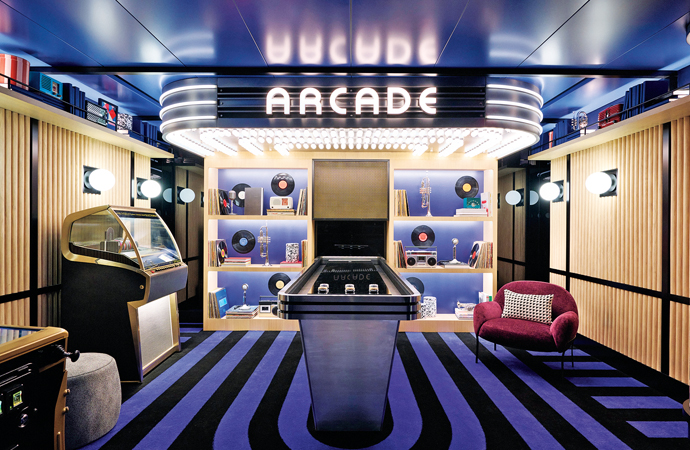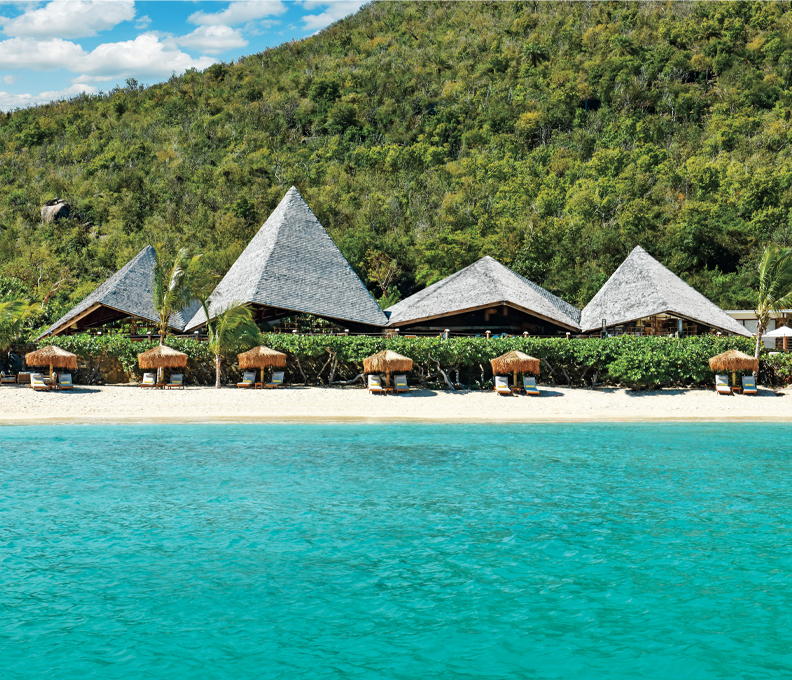Innovative Design Is Enhancing Airports Across the Globe
Airports are spending millions investing in projects like new terminals and impressive lounges
May 6, 2024

Abu Dhabi’s new terminal features an X-shaped design that reduces the average walking distance for passengers / Photo: Courtesy of Angela Sun
Architecture and design form an integral part of our daily life, even if we may not realize it. The clothes we wear, the food we eat, the places we visit, and the products we buy all incorporate design that affects how we make decisions. But consumer goods are not the only arena that uses design to encourage behavior. The travel industry does, too, from obvious venues like the hotels we visit to less likely targets such as the places we frequent in transit—airport shops, restaurants and lounges. Travel companies often tap into the expertise of notable fashion designers, architects and interior decorators to develop products and services that appeal to their customer base. Airlines and airports spend millions investing in projects like new terminals, impressive lounges and even staff uniforms to showcase their brand and lean into the latest trends. “We always dive deep into hospitality trends globally to see what’s current and what’s coming so we can assure designs are future-proofed and set to inspire at every step,” says Victoria Edwards, principal of HBA DNA, the design firm responsible for many of the world’s leading airline lounges. These include Singapore Airlines’ newest lounge at its home base of Changi Airport and a slew of new Delta Sky Club designs in airports such as Detroit, Fort Lauderdale and LaGuardia. According to experts, this is what you can expect to find.
Bringing the outdoors inside

The Louis Vuitton Lounge in Doha, Qatar / Photo: Courtesy of Qatar Airways
Over the years, one of the most notable changes in airports and lounges has been emphasizing more natural light, greenery and the sense that travelers are not trapped inside when traversing time zones. Qatar Airways’ new Al Mourjan Business Lounge The Garden at Doha’s Hamad International Airport overlooks The Orchard, an oasis of trees, fountains and seating areas. The airline’s former CEO Akbar Al Baker said the space showcases “a sophisticated way of travel, centered in comfort, wellness and nature.” These bucolic views are also available from the new Louis Vuitton Lounge, a collaboration between Qatar Airways, the fashion house and Michelin-three-star chef Yannick Alléno, which adds star power to the space and connects the dots between the airline’s premium products and premium global brands.
Designed by Matteo Nunziati, the lounge is timeless and calming without being stuck in the latest trend (which changes over time). Nunziati says the space is more like a “large domestic living room, but at the same time inspired by local tradition. The elegant, tapered shapes of the dhoni, which are the traditional boats used by pearl fishermen in Qatar, inspired the shapes of the reception desks and buffet counters. This was a project that looks to the future but does not forget the rich heritage of the region’s past.”
At the new American Express Centurion Lounge in Atlanta, a 50-year-old live olive tree is the space’s centerpiece. Audrey Hendley, president of American Express Travel, says the indoor tree is inspired by the abundance of trees around Atlanta: “In preparation for the live olive tree’s journey to our lounge at ATL, it spent a year on the banks of Lake Okeechobee in Florida to acclimate to the anticipated lower light it would experience indoors.”
Outdoor spaces are a key feature of Delta’s Sky Decks, which launched at New York JFK and later spread to Atlanta, Austin, Los Angeles and Salt Lake City.

Chase Sapphire’s lounge at New York JFK International Airport / Photo: Courtesy of Chase Sapphire
New Chase Sapphire lounges in New York LaGuardia and JFK highlight another way designers consider their end product. Dana Pouwels, head of airport lounge benefits for Chase, says the brand relied heavily on its understanding of cardmembers to help it decide how to lay out the lounge, referring to the types of seating and tables that suit solo travelers and families.
“It has been our goal to make the LGA lounge the flagship of our network,” says Pouwels.
Airports as global gathering places
Airports in Doha, Istanbul and Athens showcase art, historical pieces and other artifacts in the terminals to give the facility a sense of place. The idea of using airports as public galleries is transformative in how people view the transit experience, says Elias “Double-A” Andrews, an expert in airline management.
Permanent and rotating airport exhibitions include everything from “traditional sculptures and murals to high-tech installations and even performance art,” Andrews notes. He highlights airports in Vancouver, which has a collection of Northwest Coast Native art, including monumental totem poles, and Toulouse, France, where the region’s aerospace focus is highlighted in sculptures made from aircraft materials.
“Airport architecture often plays a role in where art is placed. High ceilings may host hanging installations, while sprawling wall spaces may serve as canvases for large murals,” Andrews says.
The physical structure of the airport is also key. This is especially true of the recently opened Abu Dhabi Zayed International Airport’s terminals for Etihad Airways. Designed to be one of the largest airport terminals in the world with a capacity of 45 million people per year, it currently sees only half that, assuring travelers have an enormous sense of space with minimal crowds. This can affect people’s perception of passing through an airport.

The open-air Delta Sky Deck at LAX / Photo: Courtesy of Delta Air Lines
Airport designers and architects must work hand in hand to develop spaces that fit the project’s main goal and prove efficient for travelers. Jens Hardvendel, director at Kohn Pedersen Fox (KPF), a New York-based architectural firm, describes how the architecture of Abu Dhabi’s new airport does just that: “The X-shaped plan provides the greatest programmatic efficiencies, reducing the average walking distance between points for those leaving, arriving or transferring from Terminal A.”
Mustafa Chehabeddine, design principal at KPF, adds, “Airport requirements are in a constant state of flux as technology and security change. At Terminal A, unprecedented flexibility is created by replacing columns with mega arches. This solution produces some of the largest spans ever built in interior environments.”
Beyond art and architecture, Edwards believes that telling the airline’s story is key to the design. It can include anything from historic photography to key moments in an airline’s life. Her firm has the tall task of redesigning Air India’s lounges globally as part of the carrier’s massive overhaul with new aircraft and an elevated premium brand focus. “Visually weaving in elements of what makes the brand story unique is important,” she says. “An airline’s style should be beautifully represented through the design.”
Location, location, location
Beyond art and history, other key ways exist to reflect a particular destination. This can include bringing famous local retailers and restaurateurs into the terminal and taking transit travelers to prominent nearby landmarks.
Looking ahead, Andrews says, “In the next decade, airports and airline lounges will evolve into emotional landscapes, intertwining local culture, sustainability and technology. In these spaces we become more than just passengers traversing points on a map, but ones open to new ideas and cultures.”

Chase Sapphire’s lounge at New York JFK International Airport / Photo: Courtesy of Chase Sapphire
In tandem, design and architecture play a key role in how globe-trotting passengers use their senses, perhaps without even realizing it, to assess how they feel about where they are. Cathay Pacific even went so far as to team up with Air Aroma to design an exclusive fragrance for The Pier, its First class lounge in Hong Kong and a recent Business Traveler Award winner, using fragrances like lavender, jasmine, cedarwood and tea leaves.
Sometimes, a lounge can affect the way passengers feel, always important before or after a long-haul flight. Designers must look for ways to reduce stress points. A common issue, according to Elaine Lee, Cathay Pacific’s head of customer experience and design for ground product, is finding a seat.
“At our Hong Kong lounges, most dining tables seat four, but we noticed that more customers travel alone or in pairs, and people were telling us that they couldn’t find a table because there weren’t enough seats,” says Lee. This led the airline to swap out larger tables for smaller ones in many lounges, including The Pier. After all, a lounge is about creating a sense of calm during the travel experience, and that means using all the senses while eliminating points of frustration. Take note the next time you’re in a cleverly designed airport space: You may notice how architects and designers have used emotion, local flavor and a little common sense to create something new and functional that makes your trip just a bit better.



